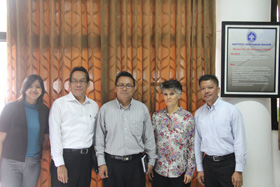DSM Indonesia conducts studium generale on enzyme

As a form of concern on the progress of animal nutrition in Indonesia, DSM Indonesia recently conducted a studium generale in the faculty of animal science of Bogor Agricultural University discussing about feed enzyme in poultry nutrition. As the speaker, DSM Indonesia invited Dr. Rosaline Angel from the department of animal and avian sciences of the University of Maryland.
The animal nutrition and health manager of DSM Indonesia, Suaedi Sunanto said that last year the faculty of animal science of Bogor Agricultural University had launched to align with international education standards. “That is why we are interested to cooperate in order to bridge the gap between animal nutrition science and the industry,” he said.
In her presentation, in front of 30 participants, Dr. Angel said that enzymes are protein and have inhibitor and activator. Enzymes are temperature and pH specific. About this pH specific, she estimated that pH range was more important than pH optimum. She also added that enzymes are substrate specific. Because the substrate is important in the action of enzymes, she reminded to keep our eyes on the substrate.
About the situation in the US, Dr. Angel informed that phytase had been used as much as 95% in broiler feed. “The industry become more adaptive because of the soaring price of inorganic phosphate,” she said. While in Europe, she informed that xylanase had been used around 100% in poultry feed because they use barley and wheat.
The interesting thing in the future, according to Dr. Angel, is to put enzymes in feed together. Not many researches on enzyme combination have been done. She then reviewed the research conducted by Wu et al. (2004) investigating the effect of diet energy ingredient on impact of phytase in broiler. On wheat plus phytase treatment, there were no changes in phosphorus digestion compared with the treatment of wheat without the addition of phytase. “There is something in the digestive tract that didn’t allow to access phytic molecule,” she guessed the cause. But on wheat plus phytase plus xylanase treatment, the phosphorus digestion was significantly different. “In this case, xylanase made phytase could work,” she said.
Dr. Angel said that she and her team would conduct an enzyme combination research of xylanase, phytase and protease. “We are doing it next year. And it has 7 negative controls. We have to have a negative control for the xylanase alone. One negative control for the phytase. One negative control for the protease. And 4 other negative controls for the combination,” he explained.
Specifically on protease, Dr Angel revealed that proteases were more difficult to apply commercially compared with other enzymes. “Why? In phytase, you just look at P and Ca. But in protease, you will look at 20 amino acids,” she stated the reason.
DSM’s enzyme business in Indonesia
About the situation in Indonesia, Sunanto said that phytase had been used as much as 95% in layer feed. “While in broiler feed, it still constrained by the issue of heat stability. Other enzymes such as carbohydrase and protease, its uses are still low, may be around 15% to 20%,” he said.
Regarding to the situation, Sunanto informed that the development of enzyme business of DSM in Indonesia in 2010 was quite good. “The growth reached 30% with the total value around IDR 20 billion. We hope that enzyme business could be our new source of growth besides vitamin business which is our main business,” he told.
“DSM’s enzyme products are very innovative. We have presented a fourth-generation phytase. And we will soon launch new generation phytase named Ronozyme HiPhos. We also have a single-component protease and 6 types of single-component carbohydrase,” he added.













